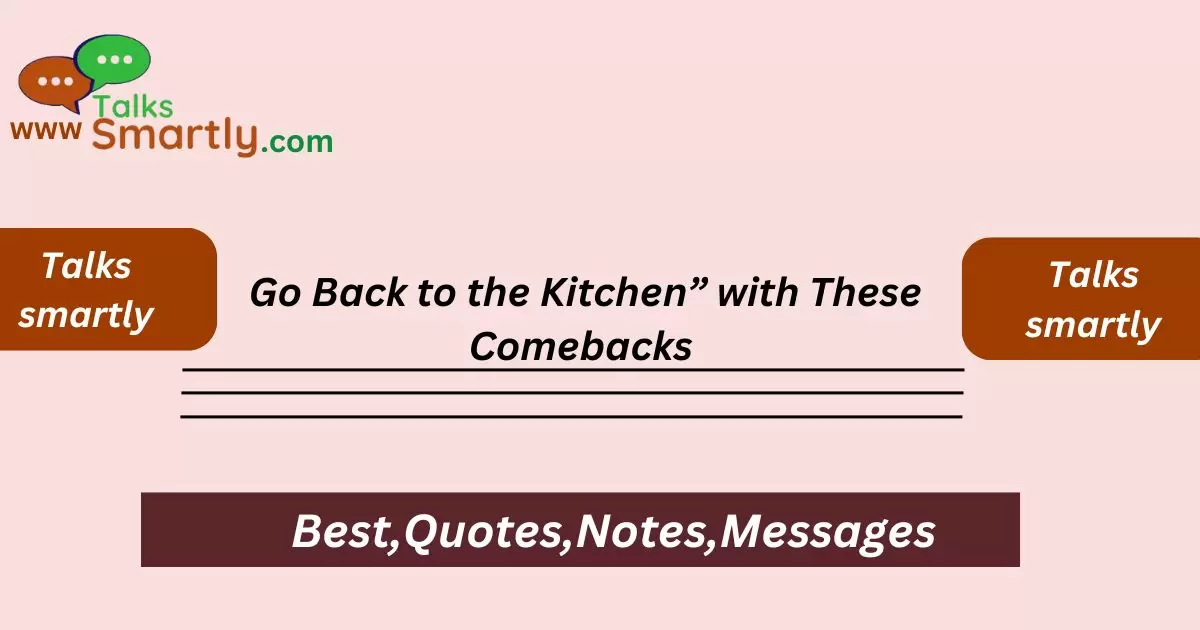Introduction
“Empower with witty comebacks challenging gender stereotypes like ‘Go back to the kitchen,’ celebrating women’s talents beyond traditional roles.”
In today’s world, gender stereotypes continue to persist despite strides towards equality. One common stereotype is the phrase “Go back to the kitchen,” often used to belittle women.
This article aims to empower and educate with witty comebacks that challenge such outdated notions. By reclaiming the narrative and showcasing women’s diverse talents beyond the kitchen, we celebrate resilience, wit, and the triumph of gender equality.
The Classic Reversal
This section highlights turning traditional sexist remarks on their head, reclaiming power through clever responses.

Emphasize confidence and intelligence in responses, making it clear that traditional gender roles are outdated and limiting.
- Example: Responding with humor like, “Sure, I’ll go to the kitchen right after I finish running this company.”
- Example: Using wit to say, “Why stop at the kitchen when I can run circles around you in any room?”
Flipping the Script: Gender Equality Wins
Discusses how challenging stereotypes promotes equality and respect.
Advocate for fairness and respect, framing discussions around capabilities rather than stereotypes.
- Example: “Equality means my skills are valued regardless of gender.”
- Example: “Let’s celebrate competence, not outdated expectations.”
Why the Kitchen? The Whole House is Mine
Explores how women excel in diverse roles beyond just domestic ones.
Highlight the multifaceted nature of modern women’s roles, emphasizing balance and capability in all areas of life.
- Example: “I manage a household as well as excel in professional arenas.”
- Example: “I own my home and my career path.”
Turning Stereotypes on Their Heads
Shows the power of overturning biased assumptions with facts and humor.
Use anecdotes and achievements to demonstrate the real-world impact of challenging stereotypes.
- Example: “Breaking stereotypes with every successful project I lead.”
- Example: “Turning assumptions into admiration through my accomplishments.”
Reclaiming the Kitchen with Pride
Discusses embracing culinary skills as a source of strength and creativity.
Encourage pride in domestic skills, portraying them as valuable and empowering.
- Example: “My kitchen is my lab for creativity and innovation.”
- Example: “Cooking isn’t just a chore; it’s an art form and a passion.”
From the Kitchen to the Boardroom: Women’s Versatility
Highlights women’s ability to transition seamlessly between domestic and professional spheres.
Showcase adaptability and skill transferability across different roles, challenging the idea of fixed gender roles.
- Example: “From managing meals to leading meetings, versatility is my forte.”
- Example: “My skills in the kitchen translate to strategic thinking in the boardroom.”
Embracing Culinary Skills as Strength
Discusses how culinary skills reflect creativity, organization, and leadership.
Promote culinary skills as valuable assets that demonstrate creativity and management abilities.
- Example: “Cooking is more than feeding; it’s about managing resources and inspiring tastes.”
- Example: “Turning recipes into culinary masterpieces requires precision and creativity.”
Breaking Boundaries, One Dish at a Time
Shows how women defy expectations by excelling in traditionally male-dominated fields.
Advocate for breaking down barriers in all fields, celebrating achievements that challenge norms.
- Example: “Breaking barriers in the culinary world with innovative dishes.”
- Example: “Leading kitchen teams and setting new standards in gastronomy.”
Redefining Domestic Roles in Modern Times
Discusses how modern women redefine and expand traditional domestic roles.
Emphasize partnership and shared responsibilities in modern households, promoting equality in roles.
- Example: “Managing household responsibilities while pursuing career ambitions.”
- Example: “Sharing responsibilities equitably to create a balanced home environment.”
Challenging Outdated Notions with Wit
Highlights using humor and intelligence to challenge stereotypes effectively.
Encourage using wit to disarm stereotypes, fostering constructive dialogue rather than defensiveness.
- Example: “Responding to ‘go back to the kitchen’ with ‘Why limit myself to one room?'”
- Example: “Turning a sexist joke into an opportunity for a thoughtful discussion on equality.”
Proving Competence Beyond Stereotypes
Discusses showcasing competence and skill regardless of gender stereotypes.
Focus on competence and results to challenge biases, emphasizing meritocracy over stereotypes.
- Example: “Demonstrating leadership qualities through successful project management.”
- Example: “Turning doubters into supporters with consistent, high-quality performance.”
Reversing Roles with Humor and Grace
Shows the power of humor and grace in responding to sexist remarks.
Advocate for using humor tactfully to educate and challenge biases, promoting respect and understanding.
- Example: “Responding with ‘I’ll go to the kitchen as soon as you fetch me a coffee.'”
- Example: “Turning a sexist comment into a chance to educate with humor and poise.”
Fun and Smart Ways to Respond to “Touché”
Turning Insults into Empowerment
Discusses transforming negative remarks into opportunities for empowerment.
Encourage resilience and self-empowerment in the face of adversity, turning negatives into positives.
- Example: “Using ‘Go back to the kitchen’ as motivation to excel in every area of life.”
- Example: “Turning insults into fuel for personal growth and achievement.”
From Housewife to CEO: Breaking Barriers
Highlights women’s journeys from traditional roles to leadership positions.
Celebrate diverse career paths and leadership achievements, showcasing women’s success stories.
- Example: “From managing a household to leading a Fortune 500 company.”
- Example: “Transforming domestic skills into strategic leadership capabilities.”
Cooking Up Success in Every Field
Shows how culinary skills symbolize broader success and achievement.
Highlight entrepreneurship and career diversity stemming from culinary passions, inspiring others to pursue their dreams.

- Example: “Using cooking skills to build a successful catering business.”
- Example: “Turning passion for food into a career in culinary arts and hospitality.”
Defying Gender Norms with Confidence
Discusses defying societal expectations with confidence and self-assurance.
Advocate for self-confidence and belief in one’s abilities to overcome stereotypes and societal pressures.
- Example: “Challenging gender norms by excelling in traditionally male-dominated fields.”
- Example: “Leading with confidence and proving gender is not a limitation.”
Witty Replies to Antiquated Ideas
Highlights using clever responses to challenge outdated beliefs and ideas.
: Encourage using wit to foster understanding and dialogue, promoting equality and respect in interactions.
- Example: “Responding to stereotypes with humor and a quick wit.”
- Example: “Using clever comebacks to shift conversations towards equality and respect.”
Empowering Women in All Spaces
Discusses empowering women to excel in any environment, regardless of stereotypes.
Advocate for inclusive environments and support networks that empower women to succeed in any space.
- Example: “Supporting women’s achievements in diverse fields, from STEM to the arts.”
- Example: “Creating opportunities for women to thrive in traditionally male-dominated industries.”
Showcasing Multi-talented Women
Highlights women’s talents and achievements across various disciplines.
Highlight diversity and multifaceted talents, challenging narrow perceptions of women’s capabilities.
- Example: “Celebrating women who excel in both professional and personal realms.”
- Example: “Recognizing the diverse talents and contributions of women globally.”
From Kitchen to Innovation: Women Leading Change
Shows how women drive innovation and change beyond traditional roles.
Promote women’s leadership in innovation and technology, showcasing their impact on global progress.
- Example: “Using culinary expertise to innovate new food technologies.”
- Example: “Leading research teams in food science and nutrition.”
Celebrating Women’s Contributions Everywhere
Discusses acknowledging and celebrating women’s contributions in all aspects of society.
Advocate for recognition and appreciation of women’s diverse contributions, fostering a culture of respect and equality.
- Example: “Honoring women’s achievements in politics, business, arts, and sciences.”
- Example: “Recognizing the invaluable roles women play in shaping communities and economies.”
From Home to Hustle: Women’s Dynamic Roles
Explores how women manage diverse roles with skill and determination.
Highlight the importance of support systems and work-life balance in empowering women to succeed.
- Example: “Balancing family responsibilities with a successful career.”
- Example: “Navigating multiple roles with grace and efficiency.”
Turning Domestic Stereotypes into Triumphs
Shows how women redefine domestic roles as sources of strength and accomplishment.
Promote the value of domestic skills in professional and personal success, challenging stereotypes effectively.
- Example: “Turning cooking skills into a thriving culinary business.”
- Example: “Managing household responsibilities while pursuing advanced degrees.”
The Kitchen as a Place of Power and Creativity
Discusses how the kitchen symbolizes creativity, leadership, and innovation.
Highlight the kitchen as a space for creativity and innovation, showcasing its importance beyond traditional roles.
- Example: “Using culinary arts to promote cultural exchange and understanding.”
- Example: “Turning traditional recipes into symbols of cultural heritage and innovation.”
Defying Expectations with Boldness
Discusses how bold actions challenge societal expectations and stereotypes.
Advocate for boldness and resilience in breaking barriers, encouraging women to pursue their ambitions fearlessly.
- Example: “Taking leadership roles traditionally held by men with confidence.”
- Example: “Launching successful businesses in male-dominated industries.”
From Homemaker to History Maker
Highlights women who redefine traditional roles and leave lasting legacies.
Celebrate women who redefine societal norms, inspiring others to see beyond traditional labels.
- Example: “From managing a household to influencing policy and social change.”
- Example: “Transforming caregiving roles into platforms for advocacy and empowerment.”
Navigating Stereotypes with Clever Comebacks
Discusses using intelligence and humor to challenge and navigate stereotypes.
Encourage using wit to disarm stereotypes, fostering meaningful conversations about equality and respect.
- Example: “Responding to ‘Go back to the kitchen’ with ‘Only if you can keep up with me.'”
- Example: “Turning stereotypes into opportunities for dialogue and understanding.”
Championing Women’s Rights with Humor
Shows how humor can be a powerful tool in advocating for women’s rights.
Promote humor as a means of advocating for social change, encouraging laughter with a purpose.
- Example: “Using satire to highlight absurd gender biases in everyday conversations.”
- Example: “Turning sexist comments into calls for gender equality with a smile.”
Highlighting the Fallacy of Gender Roles
Discusses debunking myths and misconceptions about gender roles.
Challenge stereotypes by showcasing diverse talents and capabilities, advocating for equality in all spheres.

- Example: “Showing that domestic skills don’t define a woman’s worth or capabilities.”
- Example: “Demonstrating leadership abilities in roles traditionally seen as ‘male-dominated.'”
Cooking Up Change: Women’s Impact on Society
Shows how women influence social change through diverse contributions.
Highlight women’s roles as change-makers, inspiring others to contribute to positive social change.
- Example: “Leading initiatives that promote gender equality in workplaces and communities.”
- Example: “Using influence to advocate for policies that support women’s empowerment.”
Owning the Kitchen and the Conversation
Discusses how women assert authority in discussions about their capabilities and contributions.
Encourage women to take ownership of their narratives, emphasizing their expertise and leadership.
- Example: “Asserting expertise in culinary arts and challenging stereotypes about women’s roles.”
- Example: “Leading conversations on gender equality with confidence and knowledge.”
Breaking the Mold: Women’s Diverse Achievements
Highlights the breadth and depth of women’s achievements across various fields.
Showcase the diversity of women’s accomplishments, challenging perceptions and inspiring future generations.
- Example: “Celebrating Nobel laureates, CEOs, artists, and activists who redefine success.”
- Example: “Recognizing women who excel in sports, science, and diplomacy.”
Transforming Prejudices into Progressive Dialogue
Shows how dialogue can transform prejudice into understanding and respect.
Foster open and respectful dialogue about gender stereotypes, promoting empathy and mutual understanding.
- Example: “Engaging in conversations that challenge stereotypes and promote empathy.”
- Example: “Using personal stories to humanize discussions about gender roles.”
From Domestic Duties to Global Influence
Discusses how women’s roles expand from domestic settings to global impact.
Highlight the global reach of women’s contributions, showcasing their influence on a broader scale.
- Example: “From managing a household to leading international organizations.”
- Example: “Using advocacy skills developed at home to address global challenges.”
Combating Sexism with Smart Responses
Shows how intelligent responses can challenge and combat sexism effectively.
Advocate for using knowledge and wit to dismantle sexism, promoting respectful and equitable interactions.
- Example: “Responding to sexist remarks with facts and humor to promote gender equality.”
- Example: “Educating others about the damaging effects of casual sexism with grace and assertiveness.”
Empowering Retorts to Sexist Remarks
Discusses empowering responses that affirm women’s worth and capabilities.
Encourage women to respond confidently to sexist remarks, reaffirming their value and contributions.
- Example: “Responding to ‘You belong in the kitchen’ with ‘I belong wherever my talents lead me.'”
- Example: “Turning dismissive comments into opportunities to showcase competence and leadership.”
Women’s Power Beyond the Kitchen
Highlights women’s influence and leadership in diverse arenas beyond domestic settings.
Showcase women’s achievements in traditionally male-dominated fields, emphasizing their impact and leadership.
- Example: “Leading innovative projects in technology and engineering.”
- Example: “Making groundbreaking discoveries in scientific research and exploration.”
Innovative Women Shaping the Future
Discusses how women innovate and shape the future through their ideas and leadership.
Highlight women’s roles as innovators and visionaries, inspiring future generations to pursue ambitious goals.
- Example: “Developing sustainable solutions to global environmental challenges.”
- Example: “Pioneering advancements in healthcare and biotechnology.”
Addressing Sexist Comments with Poise
Shows how grace and poise can disarm and redirect conversations about gender biases.
Encourage maintaining composure and dignity in challenging situations, promoting constructive dialogue.
- Example: “Responding calmly to sexist remarks with facts and a positive outlook.”
- Example: “Turning negativity into constructive dialogue about equality and respect.”
From Stereotypes to Success Stories
Discusses how women’s stories of success defy stereotypes and inspire others.
Highlight personal narratives that showcase resilience and determination, motivating others to overcome obstacles.
- Example: “Sharing personal journeys from adversity to achievement.”
- Example: “Turning challenges into opportunities for growth and accomplishment.”
Conclusion
In conclusion, this article aims to empower readers with strategies and examples to combat sexist remarks effectively. By showcasing women’s diverse talents, achievements, and clever responses, we challenge stereotypes and advocate for equality in all aspects of life.
Let’s continue to celebrate and support women’s contributions, fostering a society where everyone is valued for their abilities, not limited by outdated perceptions. Together, we can turn every sexist comment into an opportunity for progress and empowerment.











